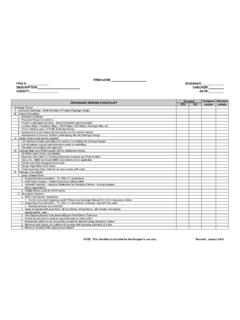Transcription of How To: Install your own drainage - Qualpro Limited
1 Qualpro Limited 2 Seaview Road Glenfield Auckland 0629. Ph (09) 441 9290. How To: Install your own drainage The most common drainage method used today for eliminating excess water from low points and other areas prone to saturated soil is the Tile Drain' or French Drain'. French drains are quite simple: in essence they are just trenches filled with aggregate, drainage pipe and filter. The advantages of French drains are low cost and easy installation and they can be covered over with turf after installation, making them less conspicuous.
2 1. Determine the drainage Path This will give you a good indication whether the job is simple enough to do yourself. Start from the spot where water is collecting, or where you want to relieve flooding. This could be inside your basement or along your foundation. Then trace a route to the lowest part of your property, or a retention pond if you have one. Be mindful of obstacles: There may be tree roots, foundations, concrete pathways or underground utilities in your path. 2. Dig the trench A French drain starts with digging a trench.
3 The depth and width of the trench can vary, but 200mm wide and anywhere from 200 to 400mm deep are common sizes and usually satisfy most needs. 3. Ensure proper slope The physical principal involved is gravity so grading is a critical consideration you must ensure that enough slope exists for the water to actually flow, and flow in the right direction. It might be adequate to check very short stretches of drain with a level to ensure that a slope exists to carry water in the desired direction. Ensure that you have a minimum of a percent slope (1 - 2 percent is ideal).
4 If unsure, employ professional help or you may be wasting time and money on a drain that will not work. If the ground is humped or undulating, this can be allowed for in your trenching so the bottom of the trench maintains a constant gradient and even flow. (1% fall is equal to 10mm over or 100mm over metres). 4. Add Geo-textile fabric (optional). To ensure your drain functions as long as possible, it's a good idea to line the trench with a good quality geo-textile fabric to further prevent soil and sand fines from reaching the drainage pipe and clogging the slots.
5 This will add cost but is definitely the do it once do it right' approach. 2012 this guide is intended for personal use and must not be printed or distributed commercially unless with the express permission of the directors of Qualpro Limited , New Zealand. Qualpro Limited 2 Seaview Road Glenfield Auckland 0629. Ph (09) 441 9290. 5. Add drainage Aggregate Add a thin bed of aggregate (Scoria or approved drainage metal) to the trench to create a smooth evenly sloping bed for the Novaflo drainage Pipe to lay on.
6 The gravel size for this use is typically around 25mm. 6. Lay the drainage pipe. The area to be drained will need a good quality slotted (punched) drainage pipe such as Iplex Novaflo (Traditionally clay tiles or pipes have been used hence the name Tile Drain') and it is highly recommended that the pipe is sleeved with a standards approved filter product such as Filtersleeve which is available pre-loaded on a dispenser for ease of fitting on site and is also available pre-fitted to the pipe from Qualpro Ltd in 65mm and 110mm diameters (Ph 09.)
7 4419290). If the drain crosses non problem sections of the land, consider switching to Novacoil (Unpunched) to avoid the water leeching from the drain into the good ground. 7. Fill with Aggregate Will the drain with more drainage metal encompassing the Novaflo pipe. Leave 50 to 100mm of space on top for on top of the gravel for turf. A popular alternative is to lay coarse sand in the top couple of inches as this provides a good medium in which turf can grow so that the trench will not be visible. If you choose this method, it is important that the sand is coarse or it won't allow water to drain through properly.
8 8. Turf the trench Ideally you want to lay the pre-grown ready-lawn on top to finish your drain off. You can lay soil and seed but there is a greater risk of fines washing through to the pipe and clogging the slots (especially if you do not have the pipe filter sleeved). Don't get in over your head Consider hiring a site consultant or similar professional for complex systems that cover large areas and require multiple lines. Proper grading, pipe-sizing and other design factors can make or break a complex drain system.
9 Feel free to call us for estimated flow rates for Novaflo and Nexusflo and advice on the right materials for your project. 2012 this guide is intended for personal use and must not be printed or distributed commercially unless with the express permission of the directors of Qualpro Limited , New Zealand.




